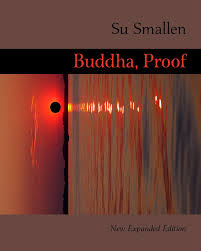
 Buddha, Proof by Su Smallen (Red Dragonfly Press, 2013)
Buddha, Proof by Su Smallen (Red Dragonfly Press, 2013)
I first encountered this book at a reading by Su Smallen for Red Dragonfly Press. A MN Book Award finalist, Red Dragonfly Press republished this expanded version with double the number of poems, which is what Smallen was reading from. Smallen is a calm and charming reader, with a voice full of wonder. The emotional response I had to her reading style was further echoed by the tone of the poetry collection itself.
Buddha explores our contemporary world, with Barbie as a frequent companion as he encounters Facebook, Cheerios, Target, and baseball, and goes to Vegas, New York City, and Paris. He finds moments of inner peace in the most unlikely of our world’s places: in Barbie’s snap purse, Facebook, and even a toaster, as in the poem, “Buddha, Toast”:
If Buddha had a favorite appliance
It would be the toaster.
Buddha puts his slice in the slot
Marked “single.”
He presses the lever down
With mindful anticipation.
The toaster makes toast
And in the other slot
The one that is not labeled
The toaster makes not-toast.
A complete meal, most satisfying.
Buddha takes his time drinking in these small wonders and everyday situations. His adventures are always tinged with whimsy and the innocence of discovery. We see this pure innocence in such poems as “Buddha, Lily”, which begins: “Buddha, bathing, contemplates the island his tummy makes / on the island is a lake his belly button makes / in the lake is Buddha, bathing, contemplating the island his tummy makes”. He looks at the world as a child would, yet he also does so with a knowing tone. He’s funny and good-natured for the most part, as we expect him to be.
Yet our more human emotions rub off on Buddha, too, with all the time he’s spending in our world. He suffers externally, not just in his mind, as in “Buddha, Release”:
“Buddha, Release”
Buddha is suffering
not the traditional wail of distress
but wracking, screaming, thrashing cries.
He is breaking up with the world, again.The muscles of the entire world contract,
release. She develops curves in her axis
so that she may support the swaying
weights of all those souls.
This heaviness is contrasted with the lightness and humor we see in other poems about Buddha. His human moments even show him getting testy with Barbie (an vice versa) in “Buddha, Barbie”:
“Buddha, Barbie”
Buddha takes aerobics class from Barbia
and hates it.[…]
He even grows to dislike Barbie herself
(“only during class”)
her cheery stamina and the way nothing
of hers jostles, just her hair.
Buddha prefers his suffering to be the mental kind.
Later in the same poem, Barbie takes a meditation class from Buddha and is equally frustrated. Yet in these moments, they are joined by the fact that they are both vulnerable and outside of their comfort zones. And somehow, by the end of the poem, they come together to find each other’s complementary spot in the messy world as it is.
Smallen uses clipped phrasing and compound words throughout the poems to demonstrate the duality and the slowing-down of the world as Buddha observes. This jolted speak gives us pause, and can sometimes be hard to follow or digest. But perhaps that’s the point, to stop and become more aware of our breath and pause to ponder. One such instance where this clipped phrasing works both ways is in the poem “Buddha, Big Sur”:
Buddha is a lens
Buddha prisms
West, East
Cliff, ocean
Within, beyond
Body, not-body
Quake, accelerate, smash
Quarks fall-rising as mist
(Up, down, bottom
Top, charm, strange)
The duality of the lines “Body, not-body” are echoed throughout with contrasting visuals of full and empty bowls, and being and not-being. With these lines, we become more aware of the philosophies behind Buddhism.
One of the main themes of Buddhism that we find in the collection is laughter (such as the ending of the poem, “Buddha, Roller Coaster”: “[…] tuned by laughing, / laughing the entire time / and a good time after that.”). Buddha is amused by our human-ness too, such as in “Buddha, Mona Lisa”:
Buddha was at first bemused
When he went to see the Mona Lisa.
All the people stood with their backs go her
For photos, sure(….)When people made it up to the guard rope,
Buddha saw each one turn, then lean back a bitAs if they had been hiking and she was
The tree named “As far as we’ll go”
When it’s time to touch and turn for home
He observes our world of dualities, quirky social norms, heartache, and lightness, but in the end, meets all of these things with laughter.
This is a very contemporary and loose interpretation of Buddhism, of course — but that’s the beautiful thing. It makes Buddhism accessible and approachable. As Smallen says in her preface, “The sense I make of Buddhism makes sense to me; this is an American embrace, of course. There is much more about Buddhism I don’t know or understand than I do. Buddhism at its core holds compassion for human existence and expresses from that compassion a sense of humor. This compassion and humor have often encouraged me.” This collection of poems melds this compassion and humor with our human vulnerabilities to create something honest.
What other poets (or authors in general) take on a deity of some sort? Do you think making deities more human helps or hurts your understanding of them?





